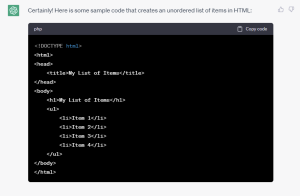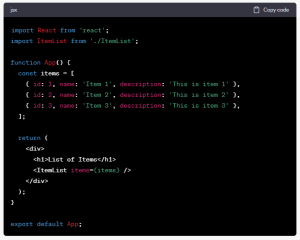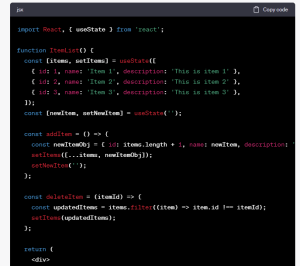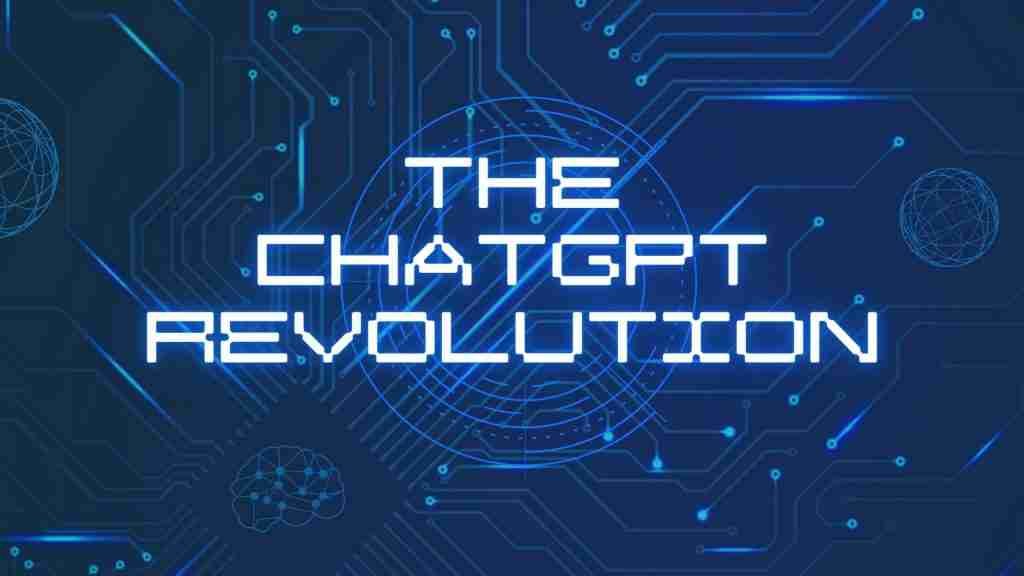In recent times, the emergence of no-code and low-code development software has simplified the process of creating applications for individuals without any programming expertise. These software programs enable users to design intricate web and mobile applications by simply dragging and dropping visual elements, without the need to write a single line of code.
One such no-code tool that has become quite popular is ChatGPT, an AI language model that can help with app creation. However, it is important to recognize that while these tools are beneficial for non-technical users, the reliability and security of the resulting applications cannot be guaranteed.
This article delves into the ways in which ChatGPT can be leveraged for the purpose of low-code and no-code app development.
Related: The ChatGPT Revolution: How To Use AI to Improve SEO (esearchlogix.com)
Table of Contents
Toggle- The Workforce Transformation Enabled by ChatGPT and Low Code Platforms
- The Impact of ChatGPT and Low Code No Code Platforms on Job Roles
- Revolutionizing Rapid Application Development: The Impact of Low Code No Code Platforms
- Integrating ChatGPT and Microsoft Power Platform: Revolutionizing Software Development
- How Can I Use ChatGPT for Low Code and No Code App Creation?
- How Can I Prop ChatGPT to My Low-Code No-Code App?
- How Can ChatGPT Identify the Potential Functionalities Within My App to Generate Corresponding Outputs?
- Here is an example of how ChatGPT can be fine-tuned on a dataset that is specific to an app’s domain:
- How Can I Use This Dataset to Fine-Tune the ChatGPT Model?
- Atomic Design Pattern and ChatGPT Model on a Dataset?
- Why Atomic Design?
- Can We Generate the Best UX?
The Workforce Transformation Enabled by ChatGPT and Low Code Platforms
ChatGPT is bringing about a significant transformation in the tech industry as it offers businesses a robust tool for automating diverse tasks, such as customer service, staff recruitment, and training. By leveraging its natural language comprehension and human-like response generation abilities, ChatGPT is revolutionizing how companies engage with customers, optimize their operations, and offer personalized experiences.
Low code no code platforms have been driving digital transformation across various industries, including manufacturing, finance, and retail, to name a few. These platforms have played a vital role in streamlining operations and increasing efficiency. They enable COOs and CTOs to save significant amounts of money, while also reducing the IT budget by 30-50%. The risk-reward ratio of low code no code platforms is highly attractive.
Nevertheless, as these two technologies continue to advance, it is becoming evident that certain job roles in these fields may become outdated.
The Impact of ChatGPT and Low Code No Code Platforms on Job Roles
ChatGPT was not created with the primary aim of replacing programmers. Its primary function is to facilitate natural language conversations. However, due to its training on a vast corpus of text, including code, it has demonstrated an aptitude for programming. OpenAI has developed Codex, a GPT-3 model optimized for code generation, to cater to the specific need for generating code.
The latest version of GPT-3, GPT-3.5, has undergone fine-tuning through reinforcement learning and has exhibited significantly higher proficiency than its predecessor. Its derivative models, ChatGPT and InstructGPT’s davinci-003, have also demonstrated exceptional programming capabilities. Nevertheless, it is important to note that Codex is still in development, and there will likely be more advanced iterations in the future. Additionally, other companies like Google are expected to launch their own competing products soon.
However, it is unlikely that organizations will entirely replace their programming teams with ChatGPT licenses, despite the advancements in GPT-3. Using a language model alone to generate code would produce a combination of functional and faulty code, making maintenance and upkeep a challenge. Nonetheless, some organizations may choose to supplement their programming teams with ChatGPT and potentially replace average developers. This trend is expected to continue as technology progresses.
Revolutionizing Rapid Application Development: The Impact of Low Code No Code Platforms
Low code no code platforms have transformed the software development process by enabling users and developers to easily convert business requirements into functional applications. By defining the data model and business rules, the platform automatically generates user interfaces for the application. Additional customization is possible through simple drag-and-drop and configuration. This approach leads to significantly shorter development times, with some estimates indicating a reduction of up to 70% compared to traditional high-code development. This not only results in cost savings but also enables faster implementation of digital transformation initiatives, with a smaller team of developers required to accomplish the same task.
Integrating ChatGPT and Microsoft Power Platform: Revolutionizing Software Development
Microsoft is heavily investing in ChatGPT and enhancing its low-code platform, Power Platform, by integrating it with Azure, Dynamics 365, and Office 365. The integration of ChatGPT with Microsoft’s Power Platform is a potent combination that promises to reduce development time even further. This integration enables developers to leverage the capabilities of ChatGPT to streamline the development process and create powerful applications quickly and efficiently.
The integration of ChatGPT with Microsoft’s Power Platform is poised to revolutionize the configuration and implementation of business process flows. Rather than manually configuring each step, users can simply input their requirements and let ChatGPT’s advanced language models generate a preliminary implementation of the business process flow. This can significantly reduce development time, resulting in a more efficient and streamlined workflow.
Related: ChatGPT Can Improve Your SEO and Optimize Link Building (esearchlogix.com)
How Can I Use ChatGPT for Low Code and No Code App Creation?
To simplify low-code and no-code app development, ChatGPT can be utilized to offer pre-trained language models that generate code templates and snippets based on user input. This is achieved by fine-tuning the model on a dataset of code snippets and templates and using it to generate code based on user requirements. Additionally, the model can help users build applications by suggesting ideas and completing code snippets as they type.
Example:
For instance, if a user wants to create a web page that displays a list of items on a no-code platform, they can ask ChatGPT to generate the code for them by providing a prompt. ChatGPT then creates a sample code snippet that can be used to create the web page.
- The user launches the no-code platform with the intention of building a new web page that lists various products.
- I want to construct a web page that displays a list of objects the user types into ChatGPT. Please create the code for me.
- A sample of code generated by ChatGPT can be used to build the website:

- The produced code snippet can then be copied and pasted into the no-code platform to produce the web page with the list of items on demand.
- Without creating any code, the user can then alter the web page’s appearance by adding additional items to the list, modifying the layout, and including new elements.
How Can I Prop ChatGPT to My Low-Code No-Code App?
There are several ways in which ChatGPT can be integrated into a low-code or no-code app:
- One approach is to utilize an API to connect the app with ChatGPT. The app can transmit user input to the API, which will then send the input to ChatGPT to generate code snippets or templates. The generated code can then be returned to the app and used to create the application.
- Another option is to use a pre-trained language model that has been fine-tuned on a dataset of code snippets and templates. This model can be integrated into the app and employed to generate code based on user input.
- In addition, a pre-trained language model can be used to offer suggestions and autocomplete functionality to the app. This can be achieved by having the model monitor user inputs and propose code snippets or templates that correspond to the input.
- It’s also possible to use a combination of these methods, such as using a pre-trained model to generate code snippets and an API to access more advanced functionality or update the model.
- Lastly, you can leverage OpenAI’s ChatGPT-3, which is a language model that can be accessed via API. It can be connected to your low-code or no-code application to provide suggestions and autocomplete functionality, as well as generate code snippets and templates.
How Can ChatGPT Identify the Potential Functionalities Within My App to Generate Corresponding Outputs?
ChatGPT can become aware of the possibilities in your app by fine-tuning it on a dataset that is specific to your app’s domain. To do this, you can develop a dataset of relevant code snippets and templates and train the model on this dataset. As a result, the model will be able to generate code snippets and templates that match the input it receives, allowing it to understand the specific capabilities and possibilities of your app.
Alternatively, you can use pre-trained models like OpenAI’s ChatGPT-3, which has a general understanding of many different domains due to being trained on a vast corpus of text. You can utilize ChatGPT-3 to generate code snippets or templates, and it will likely be able to grasp the general possibilities of your app based on the input it receives.
Moreover, you can also employ GPT-3 to provide suggestions and autocomplete functionality to your app by having the model observe user inputs and propose code snippets or templates that match the input.
Ultimately, you can also utilize GPT-3 to generate documentation and help guides for your app.
In summary, fine-tuning ChatGPT on your app’s specific dataset can provide it with a better understanding of the possibilities in your app. However, even without fine-tuning, pre-trained models like GPT-3 can still offer useful support to your app.
Here is an example of how ChatGPT can be fine-tuned on a dataset that is specific to an app’s domain:
To fine-tune ChatGPT on a dataset specific to your app’s domain, you can begin by creating a dataset of code snippets and templates that are relevant to your app’s needs. For example, if you’re developing an e-commerce app, you can create a dataset of code snippets and templates that pertain to e-commerce, such as code for shopping carts, displaying product information, processing payments, etc.
Once you have the dataset, you can use it to fine-tune the ChatGPT model. This involves training the model on the dataset and adjusting its parameters to enable it to generate code snippets and templates that match the input it receives.
After fine-tuning, you can integrate the model into your app, where it can process user input and generate relevant code snippets or templates. For instance, if a user enters the input “create a shopping cart feature for my e-commerce app,” the fine-tuned ChatGPT model can generate a sample code snippet that can be used to create the shopping cart feature in the e-commerce app.
Users can then copy and paste the generated code snippet into the app, and the shopping cart feature will be automatically created. The feature can be customized further by adding more items to the cart, changing its layout, and adding other elements, all without requiring the user to write any code.
Furthermore, the fine-tuned ChatGPT model can also help the app by suggesting code snippets or templates that match the user’s input, thereby enabling autocomplete functionality.
An example in JavaScript React:
Here is an illustration of how ChatGPT can be customized to work with a dataset unique to a JavaScript React app:
- Create a dataset of React-related code snippets and templates first, such as code for building components, handling events, managing state, etc.
- Then, adjust the ChatGPT model using this dataset. To do this, the model must be trained on the dataset and its parameters adjusted so that it can produce code snippets and templates that correspond to the input it receives.
- The model can be incorporated into your React app once it has been optimized. The model can receive user input from your app and provide code snippets or templates that correspond to that input.
- The refined ChatGPT model, for instance, will produce a sample code snippet that can be used to construct a new component in React that displays a list of items if a user enters theprompt “I want to create a new component in my React app that displays a list of items”:

- The produced code snippet may then be copied and pasted into the user’s react app, which will instantly construct the new component. Without writing any code, the user can then alter the component’s appearance by adding more items to the list, modifying the layout, and including new components.
- By offering code snippets or templates that match the input, the refined ChatGPT model can also offer suggestions and autocomplete capability to the app.
More Complex Example:
An illustration of a more complicated scenario in which ChatGPT is adjusted on a dataset particular to a JavaScript React app and incorporated into a low-code no-code platform is provided below:
- Make a dataset of important code snippets and templates for React apps first, such as code for building components, handling events, managing state, dealing with APIs, etc.
- Then, adjust the ChatGPT model using this dataset. To do this, the model must be trained on the dataset and its parameters adjusted so that it can produce code snippets and templates that correspond to the input it receives.
- The model can be integrated into your low-code, no-code platform after it has been adjusted. The model can receive user input from the platform and provide code snippets or templates that correspond to the input.
- Using the prompt “I want to create a new component in my React app that displays a list of items and allows users to add and delete items,” for instance, a user could create a new component in their React app that displays a list of items and allows users to add new items to the list and delete existing items.
- The improved ChatGPT model will produce sample code that can be used to build a new React component that shows a list of items and lets users add and remove items. This sample code may contain the following:

How Can I Use This Dataset to Fine-Tune the ChatGPT Model?
To fine-tune a ChatGPT model on a dataset specific to your app’s domain, there are several steps you can take:
- Prepare your dataset: Organize your data in a compatible format for the fine-tuning process. For instance, you can use a CSV file with two columns of prompts and corresponding code snippets or a text file where each line is a prompt followed by the next line containing the corresponding code snippet.
- Fine-tune the model: Use the prepared dataset to train the ChatGPT model. This process can be done with machine learning libraries such as TensorFlow or PyTorch. Adjust the model’s parameters to generate code snippets and templates that match the input.
- Evaluate the model: After fine-tuning the model, evaluate its performance by comparing the generated code snippets to the snippets in the dataset. This will help you determine the quality of the generated snippets and make any necessary adjustments to the model.
- Use the model: After fine-tuning and evaluating the model, integrate it into your app. Your app can send user input to the model, which will generate code snippets or templates that match the input.
Atomic Design Pattern and ChatGPT Model on a Dataset?
The atomic design methodology is a strategy used for designing systems and can be combined with a ChatGPT model fine-tuned on a particular dataset. The atomic design pattern is utilized to organize code snippets and templates in an understandable and practical way. This methodology is based on five levels of design: atoms, molecules, organisms, templates, and pages. The goal is to break down the design into its smallest building blocks, or atoms, and construct it from there.
Atoms are the fundamental building blocks of design, which can be used to create more complex structures, such as molecules, organisms, templates, and pages. For example, a button can be an atom, a search bar can be a molecule, a header can be an organism, and a page layout can be a template.
Using the atomic design pattern, you can organize your code snippets and templates in a consistent and logical manner. You can have a set of atoms that contains basic components, such as buttons and inputs, a set of molecules that comprise more complex components, such as forms and search bars, and a set of organisms that contains even more complex components, such as headers and footers.
By fine-tuning a ChatGPT model on a dataset that is based on the atomic design pattern, you can generate code snippets and templates that can be used to create new components in a consistent and logical way. The model will understand the different levels of the atomic design pattern and will generate code snippets that match the input it receives.
In conclusion, using the atomic design pattern to organize code snippets and templates can lead to more consistent, modular, and maintainable code. When combined with a ChatGPT model fine-tuned on a specific dataset, it can generate code that fits into the atomic design methodology.
Why Atomic Design?
The use of the atomic design pattern can provide many benefits when organizing code snippets and templates for a ChatGPT model. This pattern allows for a consistent and logical way to break down a design into its smallest parts, making it easy to understand and use code snippets and templates while also improving the maintainability and quality of the generated code.
One significant benefit of the atomic design pattern is the ability to reuse code, as atoms and molecules can be used across different components, reducing the amount of code needed and improving consistency. Another advantage is that the pattern facilitates the creation of a design system, enabling the creation of new components in a modular and consistent way.
Moreover, the atomic design pattern makes collaboration with team members more comfortable, as it provides clear definitions for different levels of components, making it easier to work on different parts of the codebase.
Overall, the atomic design pattern is a robust methodology for organizing code snippets and templates, especially when used in conjunction with a ChatGPT model fine-tuned on a specific dataset. It promotes consistency, modularity, maintainability, and collaboration, making the generated code more understandable and useful for all team members involved in the development process.
Can We Generate the Best UX?
To achieve the best user experience, ChatGPT can be utilized to generate code snippets and templates that match the input it receives based on the fine-tuned dataset. Fine-tuning ChatGPT on a specific dataset enables it to understand the app’s specific capabilities and possibilities, allowing it to generate code snippets and templates that match the input it receives.
In addition, by fine-tuning ChatGPT on a dataset based on the atomic design pattern, it can generate code snippets that are organized consistently and logically, following the structure and principles of the atomic design pattern. This consistency can make it easier to create new components in a modular and consistent way, which can enhance the quality and consistency of the generated code.
ChatGPT can also use user research data to generate code snippets that meet the users’ needs and ensure ease of use.
By using ChatGPT to generate code in conjunction with the atomic design pattern, a design system can be created that is easy to update and maintain over time. The organized and logical code structure makes it easier to update and maintain the code, leading to an improved user experience over time.
ChatGPT can generate the best user experience by providing a way to generate code snippets and templates that match the input it receives based on the fine-tuned dataset, following the atomic design pattern, meeting user research data, and being easy to update and maintain over time.
Conclusion
Non-programmers and non-coders often rely on ChatGPT to create custom applications such as backends, frontends, and conversational AI applications. ChatGPT’s natural language understanding feature allows it to interpret user inputs, analyze intent, and generate responses. This means that individuals without programming skills can create applications that can interact with users and perform specific tasks.
However, while these tools may appear to be easy to use, there are limitations to what non-coders and non-programmers can achieve. Applications with complex logic and workflow requirements may be difficult or impossible to create without programming skills. In addition, non-coders may find it challenging to debug and maintain their applications, which could lead to performance and security issues.
It’s also essential to note that ChatGPT’s responses are not always accurate or appropriate. The model is trained on a large dataset of text inputs, which may result in biased responses or incorrect interpretations of user inputs. Non-coders may lack the expertise to detect and correct these issues, potentially damaging the reputation of their applications.
Another significant concern with no-code development is security. Non-programmers may not have the expertise to implement robust security measures, leaving their applications vulnerable to attacks. These applications could expose sensitive user data, leading to serious consequences for both users and application owners.
In summary, while no-code and low-code development tools such as ChatGPT are useful for non-technical individuals, they come with limitations and risks. Non-coders and non-coders may create applications using ChatGPT, but they cannot guarantee their quality or security. Therefore, it’s crucial for individuals and businesses to be aware of these limitations and seek professional assistance when necessary to ensure the quality and security of their applications.






